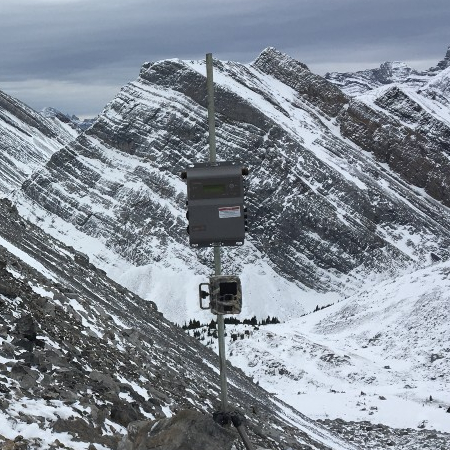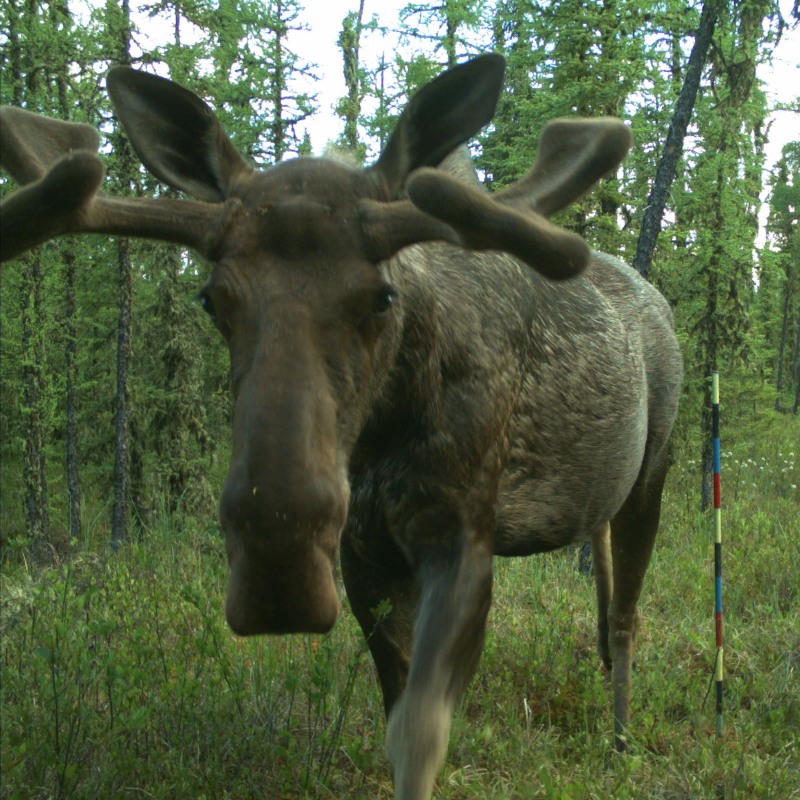Discover ABMI Data & Tools
Data Toolbox
Quick access to our data products and online reports.
Discover ABMI Data & Tools
Quick access to our data products and online reports.
 Photo Credit: Knoth
Photo Credit: Knoth
As a habitat generalist, the coyote can adapt to new surroundings by changing what it eats and where it sleeps. As a result, this species is found throughout much of Alberta, including urban areas.
 Photo Credit: Nina Veselka
Photo Credit: Nina Veselka
Photo of camera setup.
 Photo Credit: Wayne Lynch
Photo Credit: Wayne Lynch
Canada Lynx is a specialist predator of Snowshoe Hare; lynx populations fluctuate with the hare population cycle.
.jpg) Photo Credit: ABMI Camera Trap
Photo Credit: ABMI Camera Trap
Moose detection at an ABMI site, captured using a wildlife camera.
Estimating the density of animal populations over time is an important goal of wildlife monitoring programs like those at the ABMI. However, estimating density of unmarked populations is a challenging task. Based on a quadrat sampling approach, the Time in Front of Camera (TIFC) method calculates how long individual animals spend in the remote camera field of view based on the images collected, and converts this to estimates of population density.
Results from this study indicate:
For more details on this study see: Becker, M., D.J. Huggard, M. Dickie, C. Warbington, J. Schieck, E. Herdman, R. Serrouya, and S. Boutin. 2022. Applying and testing a novel method to estimate animal density from motion-triggered cameras. Ecosphere13(4): e4005.

Lead Scientist, Mammals
Marcus has been with the ABMI since 2016, and handles all mammal and camera-related analyses for the ABMI including image data processing for density estimation and habitat modelling. He has co-authored several peer-reviewed publications on these and other topics such as the influence of anthropogenic land disturbance versus climate change on White-tailed Deer expansion into the boreal region, Woodland Caribou range conservation prioritization, and Moose population monitoring.
If you have questions about the ABMI's mammal monitoring program, please get in touch: mabecker@ualberta.ca
Alberta Biodiversity Monitoring Institute. 2019. Terrestrial ABMI autonomous recording unit (ARU) and remote camera trap protocols 2019-12-21. Alberta Biodiversity Monitoring Institute, Alberta, Canada. Report available at: https://www.wildtrax.ca/home/resources/method-protocol.html
Alberta Biodiversity Monitoring Institute. 2014. Terrestrial field data collection protocols (abridged version) 2014-03-21. Alberta Biodiversity Monitoring Institute, Alberta, Canada. Report available at: https://www.abmi.ca/home/publications/1-50/46.html
Government of Alberta. 2016. Wildlife guide for Alberta's roadways. Online access available here.
Becker, M., D.J. Huggard, M. Dickie, C. Warbington, J. Schieck, E. Herdman, R. Serrouya, and S. Boutin. 2022. Applying and testing a novel method to estimate animal density from motion-triggered cameras. Ecosphere 13(4): e4005.
Laurent, M., M. Dickie, M. Becker, R. Serrouya, and S. Boutin. 2021. Evaluating the mechanisms of landscape change on White‐tailed Deer populations. The Journal of Wildlife Management 85(2):340-353.
Remote camera data management (2022). Webinar available here.
Future directions in caribou monitoring & conservation. Webinar available here.
Leveraging camera data for improved precision (2020). Presentation available here.
Large mammal density estimation: applications and assumptions of two emerging techniques (2020). Presentation available here.

.png)


